When we first got the place, an SCA friend asked if any of the cactus had cochineal bugs on it. At that time, I didn’t find any. But Monday, January 4, I found this prickly pear thickly covered with the scale insects:
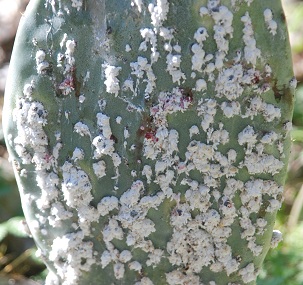 Other prickly pears nearby didn’t show any…I’m not sure why. This particular specimen is growing in a shadier part of the dry woods. Here’s another picture, more of a close-up, showing the beautiful red color:
Other prickly pears nearby didn’t show any…I’m not sure why. This particular specimen is growing in a shadier part of the dry woods. Here’s another picture, more of a close-up, showing the beautiful red color:
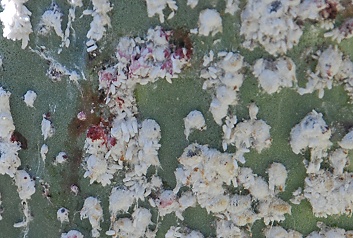
Nearly all the white coating appeared to be on the east side of this pad. Cochineal scale insects, (Dactylopius spp–4 listed in the US by Nearctica) like other scale insects, suck juices from the plant and use the white coating to protect themselves from predators and weather. Red dye is made from the crushed insects and was once second only to silver in value as an export from Mexico. I hope they survive tonight’s low-teens freeze.
On the same day, I saw a number of American Robins in the dry woods, eating juniper berries–we had seen them in the creek woods on January 1, but I wasn’t able to get a picture there.
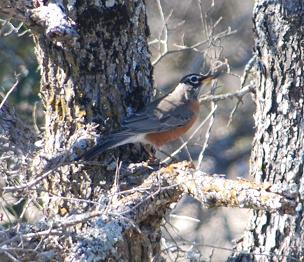
They’re very well camouflaged against leafless cedar elm–even the white ring around the eye looks like a lichen.
Speaking of lichens, this one had fallen to the ground with some rotten bark off a tree overhead:
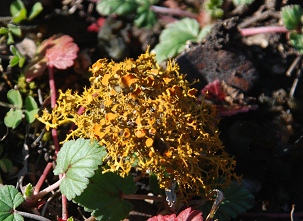
Monday I found a cool-season forb in the west grass near the dry woods that I could not at once identify…though I know it’s in the mint family (square stem, opposite leaves, aromatic.) It’s a beautiful little plant, now forming low mats of dark green with winy undertones.
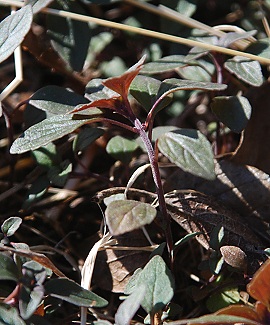
The dark green leaves show purply edges from above, but from this angle you can see the purple stems, too. And below, you can see the beautiful royal purple of the underside of the leaves.
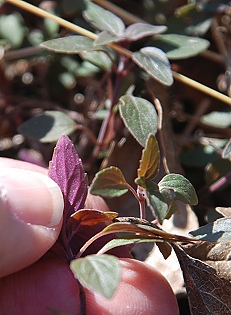
I can’t describe the aroma–except that I want to try cooking with it, it’s that kind of herbal good smell. It’s in an area where there’s a lot of Prairie Brazoria in mid-spring, but I’m not sure this is the same plant. If it survives the hard freezes predicted (and it probably will–it must be a native) I’ll try to find out exactly what it is and get some growing nearer the house.
Comment by Doranna — January 6, 2010 @ 8:52 pm
Oh! We had that stuff on some prickly pear in Flagstaff (not that it thrived at that altitude, but it cropped up here and there). I wondered what it was!
Comment by elizabeth — January 6, 2010 @ 11:49 pm
In this hemisphere, where the prickly pear is native, ditto the cochineal bugs, the pear and the bugs both have enemies to keep their numbers down
Comment by elizabeth — January 7, 2010 @ 10:14 am
I’m wondering how much of the scale you can take off each infested pad, to leave a “starter” for the rest of the plant for further production. I’m also wondering how to get the scale insects off without ending up perforated myself.
Comment by OtterB — January 8, 2010 @ 10:41 am
Okay, you made me curious and I went off googling. This article at the link below describes how the cochineal is traditionally farmed and used. Fascinating. It doesn’t tell you how to harvest the insects without injury, though.
http://www.botgard.ucla.edu/html/botanytextbooks/economicbotany/Cochineal/index.html
Comment by Adam baker — January 8, 2010 @ 4:33 pm
As always, gorgeous pictures, and thank you very much for sharing them.
Comment by Martin LaBar — January 9, 2010 @ 6:58 am
So cochineal bugs are red under a white covering? Thanks. I didn’t know that. I knew about the red.
Comment by elizabeth — January 9, 2010 @ 9:42 am
Like other scale insects, they make the white covering as protection from weather and predators.
Comment by Gina — May 5, 2011 @ 8:40 pm
Just wondering if you ever discovered what the mint-related plant/herb with the purple underleaves was? I just found the same thing growing in an old prarie on a farm I recently moved to and also cannot identify it.